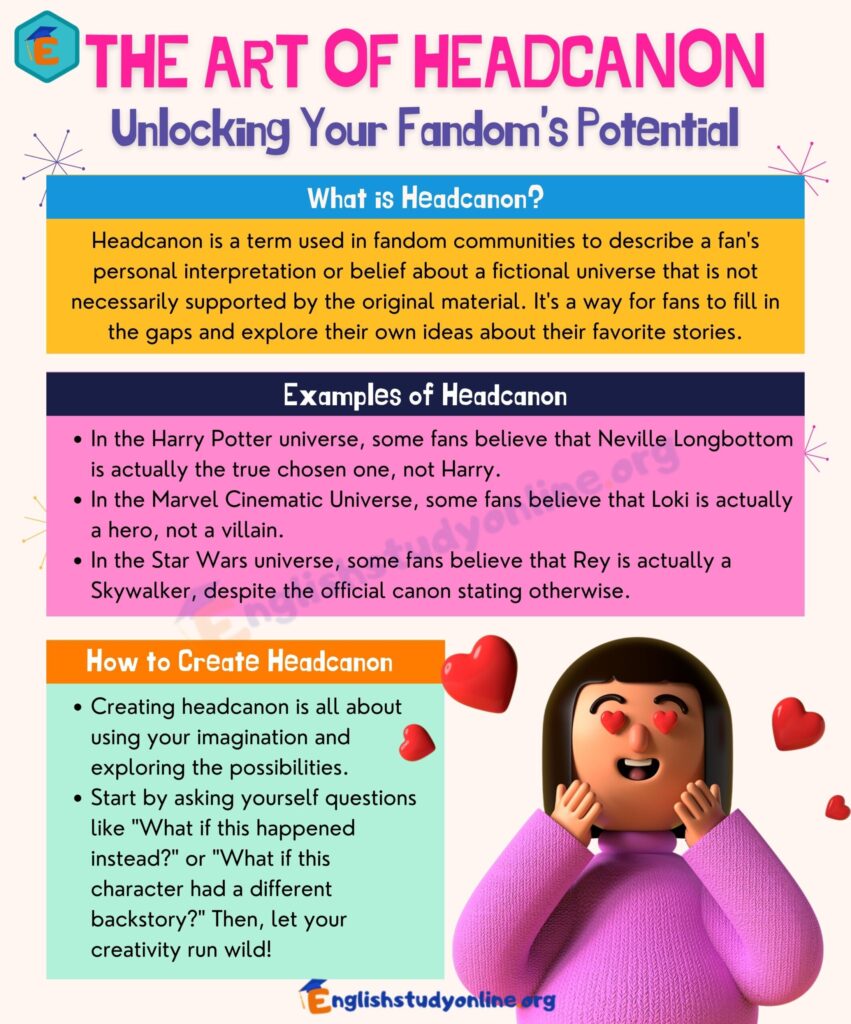Ever found yourself imagining what your favorite character eats for breakfast or what kind of music they’d listen to? You’re not alone. Millions of fans around the world engage in what’s known as headcanons — personal, imaginative interpretations that fill the gaps in a character’s story.
In an era when storytelling stretches beyond books and screens, headcanons have become a way for people to express creativity, explore emotions, and connect more deeply with fictional worlds. Much like how brands optimize for voice search to increase business visibility, fans develop headcanons to make beloved characters feel more “searchable” in their minds — easier to understand, relate to, and emotionally access.
Let’s dive into the fascinating psychology behind why we do this — and how headcanons reveal something powerful about the way our minds crave connection and narrative completion.
What Are Headcanons, Really?
A headcanon is an idea a fan believes about a character that isn’t explicitly stated in the source material. It’s a personal theory or interpretation that “feels true,” even if it’s not official.
For instance:
-
“I think Hermione from Harry Potter loves astronomy because she’s fascinated by order and structure.”
-
“Spider-Man probably listens to 2000s rock while web-slinging across New York.”
Headcanons like these make fictional characters feel real. They help fans explore layers that the original story may have skipped.
Interestingly, there are even creative tools like the Character Headcanon Generator that spark imaginative ideas about characters’ hidden traits, quirks, and backstories — helping writers, role-players, and fans alike expand fictional universes in personal ways.
The Psychology Behind Headcanons: Filling the Emotional Gaps
Why do we feel such a strong urge to build these inner worlds? Psychology gives us some compelling answers.
1. Our Brains Hate Unfinished Stories
Humans have a natural drive for closure — a concept known as the Zeigarnik Effect. When a story leaves unanswered questions, our minds itch to fill the blanks. Headcanons act as that closure mechanism.
We might not know what happens to a character after the final episode, but our brain wants to know — so it writes its own ending.
This psychological tendency mirrors the business world in some ways: when companies optimize content to increase business visibility, they’re satisfying users’ curiosity by offering complete answers through voice and search-friendly content. Fans do the same thing on an emotional level — filling gaps to make sense of their favorite worlds.
2. Headcanons Build Emotional Ownership
When you create your own interpretations, you take partial ownership of the story. It becomes yours, not just the author’s.
This feeling of ownership strengthens emotional bonds between fans and fictional worlds. Just as businesses strengthen customer loyalty by making their brands relatable and interactive (which in turn helps increase business visibility), headcanons help fans feel part of the story, not just observers.
It’s personalization at its most emotional level.
3. A Safe Space for Emotional Projection
Sometimes, headcanons are about us, not the characters. Fans often project their own experiences, insecurities, or dreams onto fictional people as a form of self-understanding or emotional processing.
For example, someone might imagine a stoic superhero secretly battling anxiety, reflecting their own struggles in a safe, symbolic way.
In the same way that businesses create empathetic, conversational content to engage their audience and increase business visibility, fans use headcanons to establish emotional empathy — a connection that transcends fiction.
Why We Crave “More” — The Curiosity Principle
Curiosity is at the heart of all fandoms. We want to know what motivates characters, how they act off-screen, or what hidden habits make them human.
The Dopamine Connection
Every time we uncover (or create) new character details, our brains release dopamine, the feel-good chemical linked to discovery and creativity. It’s the same neurological response that drives us to scroll for answers or ask voice assistants questions — behaviors businesses now optimize for to increase business visibility online.
The more we learn (or imagine), the more satisfied we feel. Headcanons essentially hack this system — giving fans the thrill of discovery again and again.
From Fans to Creators: How Headcanons Build Communities
1. Shared Creativity Fuels Connection
Headcanons aren’t just private thoughts — they’re shared, discussed, and debated in online fandom spaces. When one fan posts their headcanon on Reddit or Tumblr, it can spark hundreds of responses.
This collaborative creativity mirrors how user-generated content boosts brand awareness and helps companies increase business visibility through authentic community engagement.
Fans aren’t just consuming media — they’re co-creating it.
2. The Role of Identity and Belonging
Psychologists note that fandoms fulfill the human need for social identity — the sense of belonging to a group that shares your passion.
Discussing headcanons lets people say, “I see this character like this — does anyone else?” When others agree, it validates that sense of belonging.
That’s why headcanons spread so easily: they’re emotional language within a shared world.
How Headcanons Reflect Real-World Psychology
Let’s look at some of the deeper motivations:
-
Empathy: Imagining a character’s unseen pain or joy helps us practice empathy in real life.
-
Control: By rewriting a story in our minds, we gain control over unpredictable outcomes.
-
Creativity: It’s a low-stakes way to express storytelling instincts.
-
Connection: It deepens relationships — both with fictional characters and other fans.
This blend of emotional, creative, and cognitive satisfaction explains why headcanons are such a powerful part of fandom culture.
Actionable Ways to Explore and Create Headcanons
If you’re a writer, creator, or fan looking to explore this phenomenon further, here are some fun and practical ways to engage:
1. Start with Questions
Ask yourself:
-
What does this character fear the most?
-
How would they act in a completely different setting?
-
What hobbies or flaws might they hide?
Answering these questions gives your imagination a direction.
2. Use Creative Tools
Try using a Character Headcanon Generator to spark ideas you might never think of on your own. These tools prompt scenarios, habits, or backstory snippets that can inspire fanfiction, art, or roleplay ideas.
3. Make It Collaborative
Join fandom communities or Discord servers where fans share their headcanons. Discussing your interpretations with others refines your storytelling and helps you see characters through new emotional lenses.
4. Write It Out
Don’t just think it — write it. Turn your headcanon into short stories, dialogues, or fan comics. Sharing your content can also increase business visibility if you’re a creator or blogger, since fan-based content often goes viral within niche communities.
How Headcanons and Voice Search Have a Hidden Parallel
At first glance, headcanons and voice search optimization might seem unrelated — but both reveal how humans crave personalized, conversational interaction.
When optimizing a website for voice search, businesses aim to sound human and approachable, using natural language to answer real questions — the same instinct that drives fans to “talk” to fictional characters through their headcanons.
In both cases, understanding intent (whether a fan’s emotional intent or a customer’s search intent) is key to deeper engagement — and, ultimately, to increase business visibility in any sphere, fictional or real.
Conclusion: The Story Never Really Ends
At the heart of every headcanon lies a simple truth: we don’t want stories to end.
Whether it’s the final page of a novel or the last episode of a show, the desire to know more about characters keeps our imaginations alive. It’s a creative form of connection — an emotional continuation that lets us participate in the narrative rather than just consume it.
Just as companies use innovative strategies to increase business visibility, fans use creativity to increase emotional visibility — bringing characters out of the shadows and into new, personal dimensions.
Headcanons prove that storytelling doesn’t stop at “The End.”
It evolves, adapts, and lives on — in every fan’s heart and imagination.
FAQs
1. What does “headcanon” mean in fandom culture?
A headcanon is a fan’s personal interpretation or belief about a character, event, or relationship that isn’t officially stated in the source material. It’s a creative way to expand and personalize the story.
2. Why do people create headcanons?
People create headcanons to fill story gaps, explore emotions, or connect more deeply with fictional worlds. It’s part creativity, part emotional expression, and part community bonding.
3. How can I generate creative headcanons easily?
You can brainstorm your own or use tools like a Character Headcanon Generator to inspire unique ideas about your favorite characters — from their hidden fears to secret hobbies.



